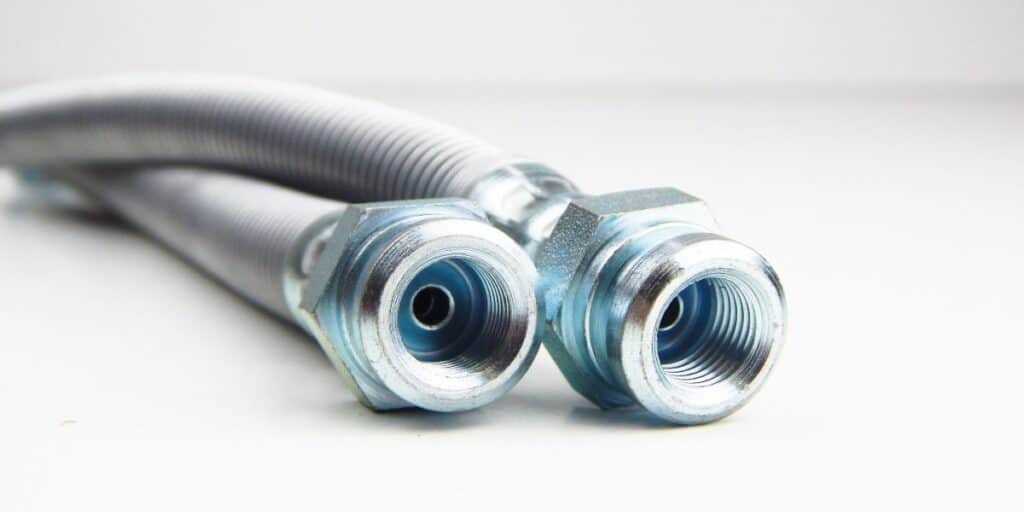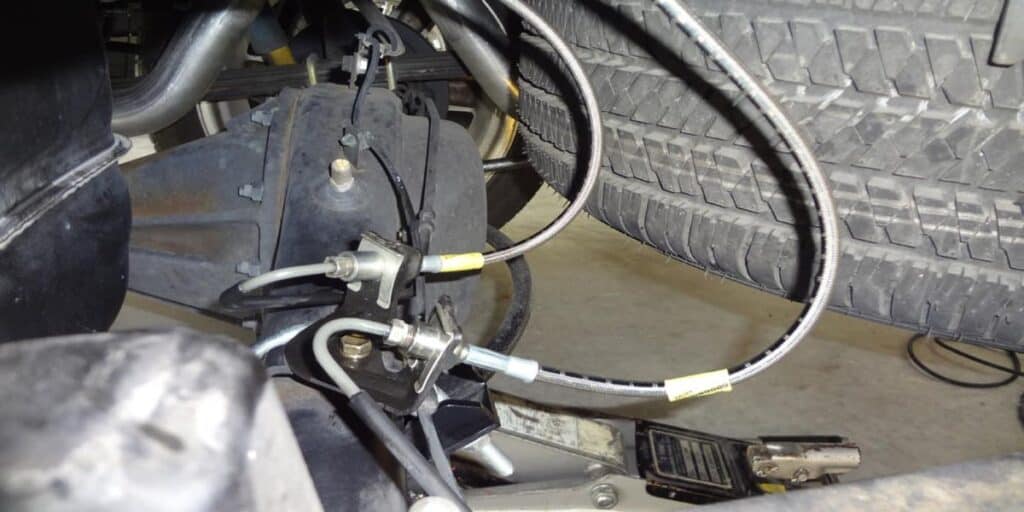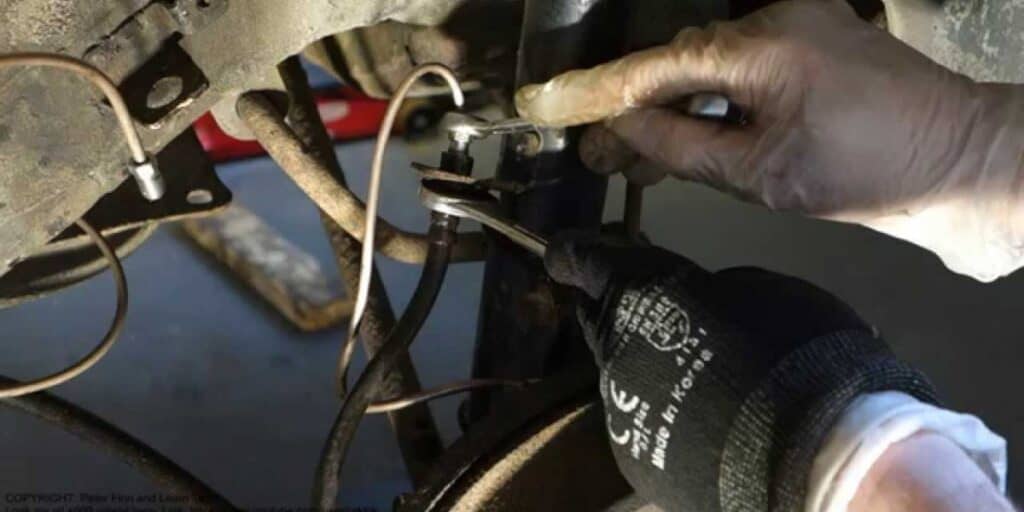Difference between brake line and hose Brake line
Slowing down your car to halts occurs in a series of steps. First, the brake pedal needs to be applied. When you do this, the master brake cylinder is triggered, and hydraulic pressure is generated. However, this pressure needs to get to the wheel brakes for you to experience the braking effect, a process aided by the brake fluid and occurs en route the brake lines.

Brake Hose
Brake hoses are important components of the braking system. On normal use, most run 8 to 10 years before requiring a replacement. While brake hoses usually have a multi-layer fabric sandwiching an outer rubber and a special inner, others have a stainless steel braiding. The latter types last longer, and because they don’t undergo significant expansion, they allow for more exact braking. Harsh weather and regular exposure to heat are primarily responsible for the loss of brake hose function. Cars are equipped with many brake hoses, so it takes some experience and troubleshooting to know which is faulty if any goes dysfunctional. Knowing where to look and finding the damaged or faulty brake hose could be all that’s needed to avoid costly repairs. Always ensure to have a professional mechanic inspect your car if you suspect some fault in your braking system. Thankfully, a faulty brake hose will present a few signs, and here are some to keep in mind.
1. Abnormally Low Brake Fluid Level
You know to check the brake fluid if your brakes don’t respond normally. A low brake fluid level might signify a faulty brake hose. The brake fluid should fall within normal levels if the hydraulic system is in good condition. However, if you need to regularly top up the brake fluid level, and lose this fluid on applying the brakes, consider having a mechanic inspect your braking system and replace faulty hoses if they are the problem.
2. Hose Leaks
Leaks are another sign of one or more bad brake hoses. To confirm if this is the problem, let someone apply the brake pedal and look under the tires for squirts of fluid. If you see fluid coming out, there’s a good chance your hydraulic system is bad and needs immediate inspection. You don’t want to ignore this problem as it will only get worse the more you apply the brakes, and this may ultimately rupture the hose and make your car a safety risk for you and other road users.
3. Soft brake pedal
A soft brake pedal is perhaps the most common sign of a faulty brake hose. You’re likely to experience consistent loss of pressure once the brake hose starts losing fluid, which will become evident when you apply the brakes. If your pedal is mushy, your hydraulic system will not work efficiently, and this will in turn compromise the braking system. Since slowing down your car is crucial for safe driving, it’s always important to inspect and repair any problems with the braking system before hitting the road.

Signs and Symptoms of Faulty Brake Lines
Brake lines are usually built to last the entire life span of your car. But they rarely do, and will eventually need to be replaced once they become damaged or bent. Leaving a faulty brake line unattended could compromise your car’s braking system and make stopping difficult, which is the last thing you want in an emergency driving situation. Regular car inspection can help you spot signs of damaged or faulty brake lines. Damaged metal brake lines may present with one or more of the following signs.
1. Brake pedal going abnormally low
Sure, your brake pedal will go down when applied, but if it goes unusually low to the floor before the brake works, there’s a good chance your brake line is faulty. As with any other component of the braking system, you ideally want to stop using your car until this problem is fixed. If you’re unsure what the problem is, having a professional mechanic inspect your car is what you want.
2. Moist or Visibly Corroded brake lines
The brake lines are located beneath the car, running from the reservoir to the brakes. So you might be able to detect and inspect it if you are familiar with cars. If the brake lines are visibly corroded or ladden with moisture, they are likely bad and leaking fluid already, in which case you want to have them replaced before putting your car on the road.
3. The Brake Fluid Light Stays On
The brake fluid light could be the most important pointer of a damaged brake line. This light turns on if your reservoir is running short of brake fluid, which usually occurs when a faulty brake line is leaking fluid. If you suspect this is the problem, have a professional inspect your car and make necessary repairs.
4. Leakage
Rubber lines might degrade to an extent they can’t prevent brake fluid leakage. Rubber lines are less durable than steel ones and are more likely to experience this problem early on. Over time, however, steel components will also wear out and leak fluid. Severe leaks should not be ignored as contact with the brake sensor or wheel speed sensor could lead to further damage and costly repairs.

Knowing When to Replace Brake Lines & Hoses
At some point, the brake lines and hoses in your car will wear and need to be replaced. Consider replacing these parts when you notice the following:
1. Internal corrosion and degradation
Corrosion will wear out metal tubes in the long run. And it’s a strong sign that you need to schedule a replacement service. Your brake fluid will inevitably absorb water, which is why flushing is important. If you ignore this routine service, water will accumulate inside the metal brake lines, and this will over time enhance corrosion and cause cracks to develop internally. These signs may not be evident until they become full-blown and cause holes to form on the outside. When this occurs, you might lose brake pressure. Rubber hoses are naturally prone to degradation due to extended exposure to heat and water. While the inner lining is built to resist fluid, it may crack, in which case brake fluid will find its way, leading to visible bulges or cracks on the outer rubber layers.
2. Rupturing
Since rubber hoses are subject to abuse from road debris, UV rays, salt, and other impurities, it’s only a matter of time before they give up. Also, when the inner components are degraded, the outer layers will eventually suffer the same fate and may lead to loss of brake fluid. Thankfully most cars today are equipped with dual brake systems, designed to ensure you have a backup in place if anything goes off.
3. They Collapse
When a section of the brake line collapses, that area is sealed off the fluid system and supply is cut off to the wheel it serves. With the caliper now running on lower fluid pressure, braking action is also affected, resulting in loss of balance that pulls your car to one side. While rubbers degrade from the inside, steel braided ones are more resistant, though the latter may suffer permanent damage following sustained impact from flying debris.
Whatever the cause, routine inspection will make it easy to detect potential faults and avoid costly repairs. If you suspect any problem with the brake lines in your car, contact us today. Our team of experts are happy to run a comprehensive inspection service to keep your car in good, roadworthy shape.
